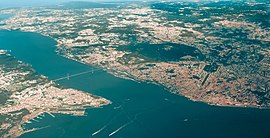
Back Àrea Metropolitana de Lisboa Catalan Metropolitní oblast Lisabonu Czech Metropolregion Lissabon German Erdê Lizboniyo Metropolitan DIQ Área metropolitana de Lisboa Spanish منطقه کلانشهری لیسبون Persian Lissabonin metropolialue Finnish Région métropolitaine de Lisbonne French Airal Metropolitan de Lisbona Occitan Obszar Metropolitalny Lizbony Polish
You can help expand this article with text translated from the corresponding article in Portuguese. (May 2020) Click [show] for important translation instructions.
|
Lisbon Metropolitan Area
Área Metropolitana de Lisboa | |
|---|---|
|
Clockwise: view of the Rossio; view of Avenida da Liberdade from Marquis of Pombal Square; Parque das Nações; view of Vasco da Gama Bridge; Pena Palace in Sintra; aerial view of the Lisbon; view of Almada from the Christ the King statue. | |
 | |
| Core city | Lisbon |
| Municipalities | Alcochete, Almada, Barreiro, Amadora, Cascais, Lisbon, Loures, Mafra, Moita, Montijo, Odivelas, Oeiras, Palmela, Seixal, Sintra, Sesimbra, Setúbal and Vila Franca de Xira. |
| Government | |
| • President | Carla Tavares |
| Area | |
• Total | 3,015.24 km2 (1,164.19 sq mi) |
| Population (2023) | |
• Total | 3,049,222[1] |
| GDP | |
| • Total | €98.517 billion (2023) |
| • Per capita | €33,270 (2023) |
| HDI (2021) | 0.900[4] very high · 1st |
| Website | Official website |
The Lisbon Metropolitan Area (Portuguese: Área Metropolitana de Lisboa; abbreviated as AML) is a metropolitan area in Portugal centered on Lisbon, the capital and largest city of the country. The metropolitan area, covering 17 cities in 18 municipalities, is the largest urban area in the country and the 10th largest in the European Union, with a population in 2023 of 2,961,177 in an area of 3,015.24 km².[5][6]
The Lisbon Metropolitan Area has the largest GDP (€98.5 billion) of any metropolitan area in Portugal.[2] The region is home to the largest tech hub in the country and a majority of Portugal's major multinational corporations by revenue are based there.
- ^ "Database". ec.europa.eu. Eurostat. Retrieved 16 June 2024. Population on 1 January by age groups and sex - functional urban areas (urb_lpop1)
- ^ a b "Produto interno bruto (B.1*g) a preços correntes (Base 2021 - €) por Localização geográfica (NUTS - 2024); Anual". www.ine.pt. Retrieved 14 January 2025.
- ^ "Produto interno bruto (B.1*g) por habitante a preços correntes (Base 2021 - €) por Localização geográfica (NUTS - 2024); Anual". www.ine.pt. Retrieved 14 January 2025.
- ^ "Sub-national HDI – Area Database – Global Data Lab". hdi.globaldatalab.org. Retrieved 31 July 2023.
- ^ "Law nr. 75/2013" (PDF). Diário da República (in Portuguese). Assembly of the Republic (Portugal). Retrieved 14 August 2014.
- ^ Marques da Costa, Eduarda (2016). "Socio-Economia" (PDF). Atlas Digital da Área Metropolitana de Lisboa.







